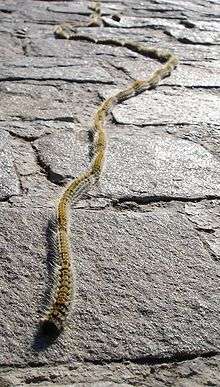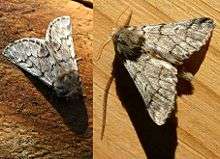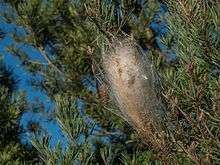Pine processionary
The pine processionary (Thaumetopoea pityocampa) is a moth of the family Thaumetopoeidae. The species was first described by Michael Denis and Ignaz Schiffermüller in 1775. Sometimes placed in the genus Traumatocampa, it is one of the most destructive species to pines and cedars in Central Asia, North Africa and the countries of southern Europe.[1] The urticating hairs of the caterpillar larvae cause harmful reactions in humans and other mammals. The species is notable for the behaviour of its caterpillars, which overwinter in tent-like nests high in pine trees, and which proceed through the woods in nose-to-tail columns, protected by their severely irritating hairs,[2] as described by the French entomologist Jean-Henri Fabre.
| Pine processionary | |
|---|---|
 | |
| Pine processionary larvae marching in characteristic fashion | |
| Scientific classification | |
| Kingdom: | |
| Phylum: | |
| Class: | |
| Order: | |
| Family: | |
| Genus: | |
| Species: | T. pityocampa |
| Binomial name | |
| Thaumetopoea pityocampa (Denis & Schiffermüller, 1775) | |
Life cycle
Though most pine processionary moths only live one year, some in high altitudes or more northern areas may survive for over two years. The adult moths lay their eggs near the tops of pine trees. After hatching, the larva eat pine needles while progressing through five stages of development. In order to maintain beneficial living conditions, silken nests are built over the winter. Around the beginning of April, the caterpillars leave the nests in the procession for which the species is known. They burrow underground and emerge at the end of summer.[3] High numbers of adults are produced in years with a warm spring.[4]
The eggs are laid in cylindrical bodies ranging from 4 to 5 cm (1.6 to 2.0 in) in length. The eggs are covered with scales which come from the female and mimic pine shoots.[3]
The larva is a major forest pest, living communally in large "tents", usually in pine trees but occasionally in cedar or larch, marching out at night in single file (hence the common name) to feed on the needles. There are often several such tents in a single tree. When they are ready to pupate, the larvae march in their usual fashion to the ground, where they disperse to pupate singly on or just below the surface.[5]

Fabre conducted a famous study on the pine processionary caterpillar where a group of them followed head-to-tail in a circle around the rim of a flower pot; they continued marching in the circle for a week. He described the experiment in his 1916 book 'The Life of the Caterpillar".[6] The study has been cited innumerable times by inspirational and religious speakers who view it as a metaphor for blindly following a leader or for confusing activity with accomplishment. Fabre considered his caterpillars to be mindless automatons, trapped because they were pre-programmed to blindly follow trails, in this case the endless one that they had laid down around the circular rim of the pot. More recent studies, however, indicate that the caterpillars were actually physically trapped on the narrow rim of the pot, their feet unable to gain the secure purchase that would be needed to descend its steep, vertical walls.[7][8] In one experiment, groups of processionary caterpillars of the same age as those observed by Fabre were placed on a flat table top and surrounded be a circular glass ring, 8 inches in diameter and 1 inch high. The caterpillars soon moved to the edge of the arena where they began to circle, one behind another. They were allowed to procession in this manner until they had a well established trail along the edge of the ring. The ring was then removed, freeing the caterpillars of any constraint to their activity other than their trail. The circular processions persisted for an average of just two minutes before the caterpillars marched off in a straight line. However, when circular trails were established in a similar manner by younger caterpillars they continued to circle for as long as 12 hours after the physical constraint was removed, a considerable time but far short of the seven days observed by Fabre.
The moth's pupal stage occurs in a white silken cocoon under soil. The pupae measure around 20 mm and are a pale brownish-yellow color that changes into a dark reddish brown.[3]
As an adult, T. pityocampa has predominantly light brown forewings with brown markings. The moth's hindwings are white. Females have larger wingspans of 36 to 49 mm (1.4 to 1.9 in), compared to a male's 31 to 39 mm (1.2 to 1.5 in).[3] Adults only live for a single day, when they mate and lay eggs. How far they are able to spread depends on how far the female is able to fly during her short time as an adult. Her average flying distance is 1.7 km (1.1 mi), with a maximum recorded of 10.5 km (6.5 mi). The species flies from May to July.[9]
Shelter building

T. pityocampa is a highly social organism. Throughout its life cycle, a pine processionary will make several shelters. The first of these are flimsy and temporary, but in the third instar, they build a permanent nest. Once their permanent nest is built, the caterpillars become foragers staying in the vicinity of the nest. The nest has no openings, so caterpillars force themselves through the layers of the shelter. The waste from the larvae's diet accumulates at the bottom of the nest.[5]
Impact of foraging
The pine processionary caterpillar is responsible for most of the defoliation of southern Europe.[10] Although pines are most susceptible to the caterpillar, other trees such as larches are also vulnerable. The caterpillars can completely defoliate trees if large quantities are present.[11]
Midwinter foraging and thermoregulation
The biologist Terrence Fitzgerald has written, "Colonies are active throughout the winter months. Activity records of colonies foraging in pine forests in mountainous regions near Barcelona, Spain, obtained with infrared activity monitors, show that the caterpillars leave their nests soon after sunset and travel to distant feeding sites on the branches of the host tree. There, they feed overnight then return to the nest at dawn." The caterpillars have been observed foraging on the coldest nights and can move at sub-zero temperatures. The nests are positioned so that they can be warmed by the sun. The caterpillars rest during the day and the heat in the nest helps them to digest their food. When they emerge from their nests in late March, they are fully grown and leave their nest processing towards pupation sites in the ground.[12]
Trail marking and processionary behaviour
The caterpillars lay down a pheromone trail from the tip of the abdomen as they advance over the branches of the host tree. Although the caterpillars also secrete silk and mark their pathways with the material, it plays little or no role in trail following. Most likely, silk helps the caterpillars grip on smooth plant surfaces. The caterpillars can distinguish old from new trails. Caterpillars preferentially follow trails marked by larger numbers of caterpillars. Trail marking enables the caterpillars to aggregate at feeding sites and allows them to find their way back to nest after feeding. When they move over the branches, caterpillars may travel head to tail in small groups or alone. In either case, they rely on the trail marker to find their way.[5]
Lengthy processions are formed when fully grown caterpillars abandon their host tree in search of pupation sites, when as many as three hundred caterpillars may travel long distances from the natal tree looking for soft soil in which to bury themselves and form cocoons. During processions, stimuli from setae on the tip of the abdomen of the caterpillar in front serve to hold processions together, taking priority over the trail pheromone or silk. A caterpillar can readily be induced to follow a model made of a wooden dowel covered with the integument of the abdomen of a killed caterpillar.[5]
Anti-predator defence
Towards the end of their larval development, pine processionary caterpillars are highly irritating to the skin. Contact with the hairs of the caterpillar can cause severe rashes (urticaria) and eye irritation. Some individuals may have an allergic reaction to the caterpillar's hairs.[5][13] Fifth-stage larvae can eject hairs when threatened or stressed; the hairs, which have the form of harpoons, then penetrate and irritate all areas of exposed skin nearby with an urticating protein.[14] Allergic reactions may follow in susceptible individuals on subsequent exposure to the hairs.[5]
Natural controls
The pine processionary is an economic pest in coniferous forests in southern Europe. It is controlled to some extent by predators, parasites and viruses which attack the moth at many stages of its life cycle:[14]
- Eggs are eaten by the orthopteran Ephippiger ephippiger.[14]
- Larvae are eaten by birds such as great tit (Parus major) and great spotted cuckoo (Clamator glandarius).[14]
- Larvae are parasitised by solitary wasps (Ichneumonidae, Braconidae) and some species of flies (Tachinidae).[14]
- Pupae are eaten by hoopoes (Upupa epops).[14]
- Adults are eaten by bats.[14]
- Larvae may be infected by the processionary moth virus Smithiavirus pityocampae.[14]
Artificial control
Efforts to control the pine processionary have included biological control using Bacillus thuringiensis, which is effective on eggs and first- or second-stage caterpillars (in September or October),[15] or insecticides such as diflubenzuron, an insect growth regulator, which can be sprayed from aircraft.[16] Monitoring can include the use of pheromone traps.[15] Older methods used insecticides in oil, inserted directly into nests, or mechanical removal of nests.[15]
References
- Kerdelhué, Carole; Zane, Lorenzo; Simonato, Mauro; Salvato, Paola; Rousselet, Jérôme; Roques, Alain; Battisti, Andrea (2009). "Quaternary history and contemporary patterns in a currently expanding species". BMC Evolutionary Biology. 9 (1): 220. doi:10.1186/1471-2148-9-220. ISSN 1471-2148. PMC 2753568. PMID 19732434.

- "FMV" (PDF). Archived from the original (PDF) on 28 July 2007. Retrieved 21 June 2013.
- "Pest profile: pine processionary moth" (PDF). Archived from the original (PDF) on 4 March 2016. Retrieved 2 July 2013.
- Mestre, João. Forest Health and Climate Changes. Universidade de Trás-os-Montes is Alto Douro, 2012.
- Fitzgerald, T. D. "Social Caterpillars" http://web.cortland.edu/fitzgerald/
- Fabre, J-H. The Life of the Caterpillar. (1916) Chapter III: The Procession.
- Fitzgerald, T. D. 2003. "The role of a trail pheromone in the foraging and processionary behavior of Thaumetopoea pityocampa". Journal of Chemical Ecology. 12: 513-532
- Fitzgerald, T. D. 2008. "Lethal Fuzz". Natural History Magazine. 177: 28-33.
- Pine processionary moth - Tree pests and diseases - Forestry Commission
- Li, S.; Daudin, J.J.; Piou, D.; Robinet, C.; Jactel, H. (9 June 2015). "Periodicity and synchrony of pine processionary moth outbreaks in France". Forest Ecology and Management. 354: 309–317. doi:10.1016/j.foreco.2015.05.023.
- GB, Forestry Commission. "Pine processionary moth - Tree pests and diseases". www.forestry.gov.uk. Retrieved 1 March 2016.
- Fitzgerald, T. D. "Social Caterpillars" http://web.cortland.edu
- "Fabre, J-H. (1916) ''The Life of the Caterpillar''. Chapter VI. The Pine Processionary: The Stinging Power". Efabre.net. Archived from the original on 9 July 2013. Retrieved 8 May 2013.
- Bonnet, Catherine and Jean-Claude Martin and René Mazet (August–October 2008). "La Processionnaire du Pin" (PDF). Stantari No. 14. INRA. pp. 29–33. Retrieved 29 December 2011.
- Control of the pine processionary
- Treatment with growth regulators
External links
| Wikimedia Commons has media related to Pine processionary. |
| Wikispecies has information related to Thaumetopoea pityocampa |
- Kimber, Ian. "71.002 BF2021 Pine Processionary Thaumetopoea pityocampa ([Denis & Schiffermüller], 1775)". UKMoths. Retrieved 4 July 2019.
- INRA website: Processionnaire du pin (in French)
- Wildlife in France: Pine processionary moth
- https://orugaprocesionaria.org/ (in Spanish)